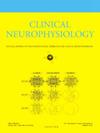Magnetoencephalography distributed source modeling identifies spatiotemporal propagation patterns of interictal epileptiform discharges
IF 3.6
3区 医学
Q1 CLINICAL NEUROLOGY
引用次数: 0
Abstract
Objective
Magnetoencephalography (MEG) is an important adjunctive method used to localize interictal epileptiform discharges (IEDs). The equivalent current dipole (ECD) method, the current gold standard modeling approach, identifies a single point source of activity. However, IEDs propagate widely and may be better represented by distributed source modeling approaches. Here, we investigate how areas of maximal IED-related activity estimated using dynamic statistical parametric mapping (dSPM) compare to dipoles and surgical resections.
Methods
We analyzed resting-state MEG recordings from 38 NIH patients. We localized areas of IED-related activity along the IED rising phase and peak using spatial clustering of the top 5% of dSPM activations, comparing localizations to ECD and surgical resection areas in seizure free patients.
Results
We identified dominant primary activation clusters in all patients and non-primary clusters in 24/38 patients. Dipoles localized closer to primary than non-primary clusters. In 12 post-operative seizure-free patients, the primary cluster center of mass was significantly closer to the resected area than dipoles and more stable over time.
Conclusions
Distributed source modeling adds to our understanding of IED propagation patterns and may be useful in IED localization for epilepsy surgery planning.
Significance
dSPM enhances pre-surgical planning by refining IED localization, potentially improving surgical outcomes.
脑磁图分布式源模型识别间歇癫痫样放电的时空传播模式
目的脑磁图(MEG)是定位癫痫样放电(ied)的一种重要辅助方法。等效电流偶极子(ECD)方法是目前的黄金标准建模方法,它确定了单点活源。但是,ied传播广泛,并且可以通过分布式源建模方法更好地表示。在这里,我们研究了使用动态统计参数映射(dSPM)与偶极子和手术切除相比,如何估计ied相关的最大活动区域。方法对38例NIH患者静息状态脑电信号进行分析。我们利用dSPM激活前5%的空间聚类来定位IED上升阶段和峰值的IED相关活动区域,并将定位与ECD和无癫痫发作患者的手术切除区域进行比较。结果我们在所有患者中发现了显性的原发性激活簇,在24/38例患者中发现了非原发性激活簇。偶极子比非主星星团更靠近主星星团。在12例术后无癫痫发作的患者中,原发性肿块中心明显比偶极子更接近切除区域,并且随着时间的推移更稳定。结论分布式源模型增加了我们对IED传播模式的理解,可用于癫痫手术计划的IED定位。spm通过细化IED定位来加强术前计划,潜在地改善手术结果。
本文章由计算机程序翻译,如有差异,请以英文原文为准。
求助全文
约1分钟内获得全文
求助全文
来源期刊

Clinical Neurophysiology
医学-临床神经学
CiteScore
8.70
自引率
6.40%
发文量
932
审稿时长
59 days
期刊介绍:
As of January 1999, The journal Electroencephalography and Clinical Neurophysiology, and its two sections Electromyography and Motor Control and Evoked Potentials have amalgamated to become this journal - Clinical Neurophysiology.
Clinical Neurophysiology is the official journal of the International Federation of Clinical Neurophysiology, the Brazilian Society of Clinical Neurophysiology, the Czech Society of Clinical Neurophysiology, the Italian Clinical Neurophysiology Society and the International Society of Intraoperative Neurophysiology.The journal is dedicated to fostering research and disseminating information on all aspects of both normal and abnormal functioning of the nervous system. The key aim of the publication is to disseminate scholarly reports on the pathophysiology underlying diseases of the central and peripheral nervous system of human patients. Clinical trials that use neurophysiological measures to document change are encouraged, as are manuscripts reporting data on integrated neuroimaging of central nervous function including, but not limited to, functional MRI, MEG, EEG, PET and other neuroimaging modalities.
 求助内容:
求助内容: 应助结果提醒方式:
应助结果提醒方式:


